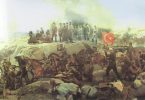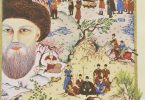Half of the world´s population calls it ¨çay¨. And the other half, ¨tea¨. The reason for this is due to the fact that those, who had brought tea through caravans heard it being called as ¨cha¨ amongst the Cantonese, while those who had brought it through seaway had adopted it from the Amoy pronunciation of ¨tay¨. While, the Italians use two separate names for tea: ¨Cia¨ and ¨te¨. It is evident that they imported tea through both caravans travelling through the spice routes as well as through the seaways. It is called ¨shai¨ in Arabic, ¨chaaya¨ in India, ¨cay¨ in the Czech Republic, ¨cha¨ or ¨ocha¨ in Japan, ¨tzai¨ or ¨chai¨ in Iran,¨chਠin Portugal, ¨te¨ in Denmark, ¨thee¨ in the Netherlands, “té” in Spain, “thé¨ in France, ¨tae¨ in Israel and ¨teh¨ in Indonesia. The word ¨thee¨, which was used in Germany until World War I, had become ¨tee¨ after the war. The Tibetans, on the other hand, found a third name for it. They call tea ¨boe´ja¨. Either way, at least there is complete agreement that the actual origin of tea goes back to China. There is a Chinese saying as such: ¨If I had the choice – I would rather not eat for three days than to not drink tea for a day.¨
HOW WAS THE USA INDEPENDENCE BREWED?
One of the precipitating factors that initiated the independence war of the United States of America was due to the revenues on tea. The British Empire that was growing enormously throughout the 17th century, had resorted to its colonies in America in order to bear the costs and economic needs that were steadily increasing. Britain, which had implemented its ¨Sugar Act¨ for the colonies in the year 1764, had raised revenue laws for higher customs. The Sugar Act was shortly followed by the Currency Act, Quartering Act, Stamp Act and others alike. It was these events that triggered the Boston Americans to protest and dump the teas loaded on the British ships into sea. The 13 colonies that had been established by the British in America united and protested against these laws and declared that the British laws on revenues cannot be implemented in the colonies. This movement resulted in ¨The Declaration of Independence¨ in the year 1776.
JUST LIKE JUDY GARLAND
Sezai Karakoç´s poem titled ‘Tea’ is as follows: ¨The tea we have is authentic. Like curved lips, dented eyes, red and blue. It flows like colourful rains from valleys. Like the ankles of a dancing woman. Tea like Judy Garland, like blood. Soaking more sun than the cities. Shattering the mountains and coming forth. Purling as it brings life. The eyes of those who drink this tea, become your eyes on my teacup. And your eyes on the teacups of others, Their eyes… all becoming tea.¨ So, who this Judy Garland mentioned in the poem? Garland, whose real name was Frances Gumm, was one of the most famous actresses during the first half of the 20th century. Sezai Karakoç, who writes a poem titled ‘Liliyar’ (My Lover Lili) with the inspiration of Garland´s 1952 movie ‘Lili’, evidently found it appropriate to draw an analogy between her and tea, which has a special place for us in the daily lives.
TEA IN ANATOLIA
It was around the 19th century when Anatolia had been widely introduced to tea. During an outbreak of cholera in Erzurum in 1895, the governor of the district had set up huge boilers at the crossroads of the city and had ordered people to drink the brewed tea for the purpose of fighting the bacteria that had spread. We do not know whether this method was successful, however, what we do know is that since that incident, tea has become an inseparable part in the lives of the city´s residents. In a short period of time, tea was able to conquer the hearts of people. So much so that they even had a riddle about it: ¨One stares at its red colour, and pours it in cups. While it billows smoke, we fall to our knees.¨ During the era when Suleiman Nazif was the governor of Baghdad, he receives a telegraph from the 3rd Army Unit. Damat Hafız Ismail Hakkı Pasha states that there is a need for 13 tonnes of tea in the next twenty four hours. Suleiman Nazif provides the following statement in reply to the telegraph: ¨We return your telegraph which was mistakenly sent to us instead of the Chinese Empire.¨
TEA PRODUCTION IN TURKEY
We owe the production of tea in Turkey to Zihni Derin. In one of his poems, Bedri Rahmi Eyüboğlu commemorates Zihni Derin, the pioneer who cultivated tea in Turkey, as thus: ¨Who found tea in Rize? Who was that holy man who fairly and silently brewed. They never taught his name.¨ Zihni Derin was the individual who, despite all of the hindrances, had been successful in tea culture in these lands, ever since the 18th century when many had constantly failed. Zihni Derin, who was born in 1880 in Muğla, completed his studies at the Halkalı Higher Education School of Agriculture in 1904. After working as a forest engineer for 4 years and teaching for another 10 years, he was appointed to the Agriculture Public Directorate in Ankara in 1920. Zihni Bey, who had come across some people, who had brought tea from Batum and cultivated it in their gardens, quickly sets off to do some research. This research that begins in 1923 eventually continues up until 1940, providing many job opportunities for many people. As a matter of fact, Turkey follows India, China, Kenya and Sri Lanka in the production of tea today. Actually, how about a nice cup of brewed tea now?









Leave a Comment